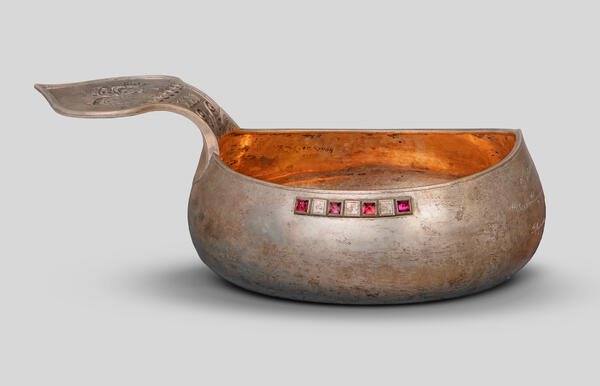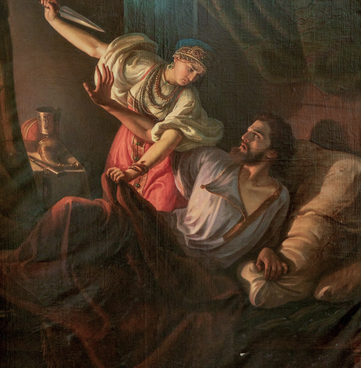In the second half of the 19th and early 20th century, Old Russian art and its traditions experienced a surge of interest. Jewelers began to turn to the long-outdated objects of Russian culture, such as kovshs (Russian ladles), bratinas (ceremonial vessels) and bowls, and were inspired to create decorative vessels, prizes, gifts and trays. Among them is a kovsh made by the House of Fabergé, which is kept in the Ivanovo Museum of Local History.
The kovsh was made in the early 20th century and is shaped like an Old Russian ladle called skobkar. The presented silver kovsh is characterized by a minimalistic yet monumental appearance and is gilded. Its handle has a bulbous shape, typical for Old Russian culture. It is engraved with portraits of bogatyrs — heroes of the Russian folk epics. The way the kovsh is decorated with such relatively inexpensive stones as amethysts seems to emphasize its own artistic value. According to ancient legends, amethyst possessed supernatural powers, brought good luck, and gave protection against black magic, diseases and getting drunk on alcohol.
The Fabergé kovsh was presented to the board of the Ivanovo-Voznesensk Weaving Manufactory (known as the Balashov factory in Soviet times) as a sign of cooperation with the L. Knop trading house, which was founded by Baron Ludwig Knop (1821–1894) from Bremen. In 1839, Knop came to Russia as a trade representative of the English firm De Jersey, which supplied English yarn to the Russian market. A true entrepreneur, Knop quickly grasped how he could profit from the shortage of modern weaving equipment in Russia. In 1852, he established the L. Knop trading house. It had branches in Saint Petersburg and Andijan. The company traded in industrial goods and supplied cotton and textile equipment to various cities, including Ivanovo-Voznesensk.
The kovsh was intended as a gift to the partnership
of Ivanovo-Voznesensk Textile Manufactory, which was founded in 1880. In April
of 1879, the factory owner Alexander Fyodorovich Zubkov from Ivanovo-Voznesensk
sold the spinning and weaving factory he owned to A.N. Novikov, N.N. Fokin and
brothers F.N. and A.N. Fokin, who founded the “Ivanovo-Voznesensk Manufactory
Partnership”.



